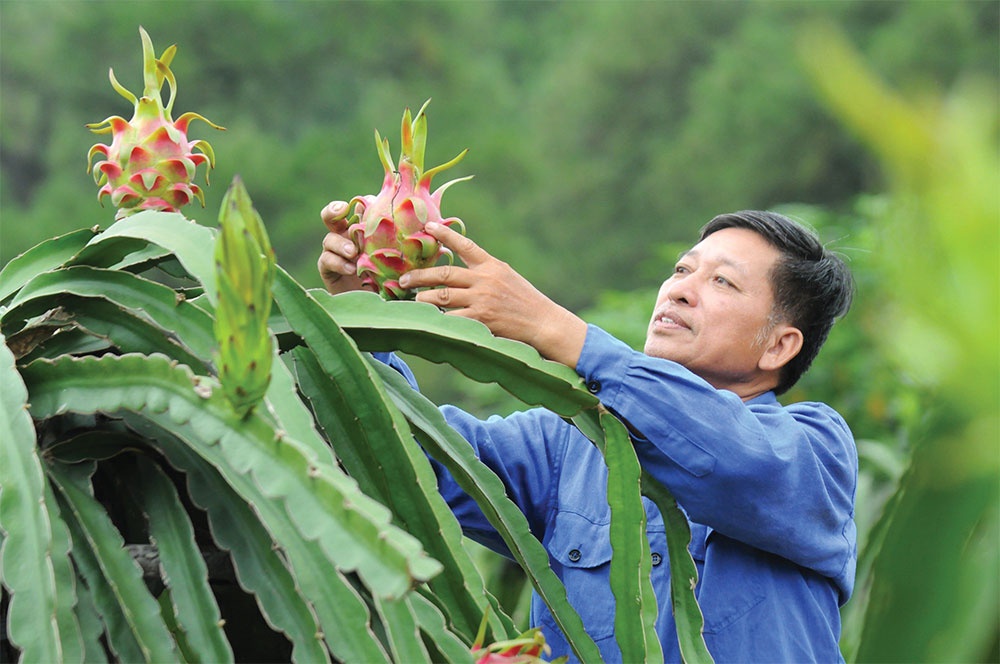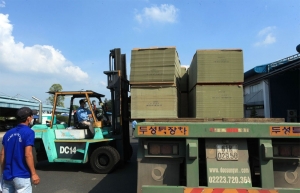Chinese activity back in vogue as fruit and veg surge
 |
| More than a dozen types of fruit can be exported to China currently, photo Duc Thanh |
Despite the recent restrictions, China remains the leading supplier of fruit and vegetables to Vietnam.
“China’s International Fruit Market project will begin this year, with the first stop being the China-ASEAN Expo in Nanning,” said Bob Wang, president of the Nanning Business Association (NBA) in China’s Guangxi province last month, when the country’s authority began to relax pandemic-related measures.
Wang seeks to boost the internet sale of pre-harvest goods. According to the Vietnam Fruit and Vegetables Association (Vinafruit), China has regained its position as the market with the highest growth in fruit and vegetable exports to Vietnam in the first eleven months of 2022, with a rise of 83 per cent over the same time last year, accounting for 40 per cent.
Developing digital trading channels and establishing an agricultural trade promotion agency in China, according to Wang, would “enable Chinese purchasers” and “reduce intermediates.” The NBA implemented this concept as part of the Vietnam Durian Expo in Nanning at the end of December.
However, Wang also stated that a few instances resulted in a “negative scenario” for Vietnam’s veg when they were permitted to be exported to the Chinese market beginning in September.
According to him, most Vietnamese enterprises still engage in “passive selling” in China’s wholesale marketplaces, which are typically open in the morning, due to a lack of awareness of market trends. In the meantime, Thai merchants were swift to comprehend the market, set pricing, and sell things effectively.
Dinh Gia Nghia, deputy general director of Dong Giao Foodstuff Export JSC, said, “China is a market with a high purchasing power, but it is no longer easygoing.” Currently, the technical standards, designs, and quality of Chinese goods are comparable to those of the American and European markets. He said that companies given export codes in 2021 must provide additional documentation to register shipments to China under Order 248 by June 30, 2023.
It is anticipated that the Chinese economy will completely reopen in the second quarter of 2023. According to Dang Phuc Nguyen, general secretary of Vinafruit, China’s effort to open, which expedites customs processing at border crossings and seaports, would enhance the quantity of commodities shipped.
Specifically, for a variety of visa-exported items to Chinese markets, including dragon fruit, passion fruit, bananas, and durian.
Nguyen is worried, however, that the quantity of Chinese vegetables and fruit entering Vietnam would grow dramatically owing to “cheaper pricing” and “better customs clearance circumstances in Vietnam” as a result of the Regional Comprehensive Economic Partnership going into force.
In the first week of January, the Vietnamese market was already booming with Chinese fruit and vegetables, including apples, grapes, carrots, and potatoes.
China continues to be Vietnam’s main export and import market for fruit and vegetable exports. China sells a large quantity of vegetables to Vietnam, but according to the Ministry of Industry and Trade’s Agency of Foreign Trade, it spends up to $15 billion annually importing vegetables, in part from Vietnam.
Numerous Vietnamese firms anticipate that the opening of a variety of Vietnamese fruit to the Chinese market in 2023 will be the driving force behind the promotion of fruit and vegetable exports.
According to the Ministry of Agriculture and Rural Development (MARD), Vietnam’s exports of fruit and vegetables totalled $3.3 billion in 2022, a 6.6 per cent decrease compared to the same time the previous year.
However, Nguyen of Vinafruit recognises that many Vietnamese users have “shifted their perspective” towards Chinese veg. In recent years, the Chinese government has increased root vegetable cleanliness and safety norms.
To fulfil local and export demand, Chinese farmers are compelled to alter their production methods and produce higher-quality items. Even Chinese enterprises and individuals invest in premium product lines to service the luxury market.
According to Nguyen’s assessment, Vietnam’s fruit and vegetable exports to China will also thrive during Lunar New Year as demand increases, but “pricing and consumption will be impacted.”
In the festive break last year, China’s strict pandemic policy had a significant impact on exports. In the first two months of 2022, exports amounted to just $260 million, a decrease of roughly 19 per cent compared to the same time in 2021. This was the first time that the Chinese market has contributed less than half of Vietnam’s overall fruit and vegetable export revenue.
The Plant Protection Department under the MARD is implementing procedures for exporting fresh pomelos and coconuts to the Chinese market after its government authorised the formal import of sweet potatoes and bird’s nests into this market. At the end of 2022, Vietnam was permitted to export 13 types of agricultural goods to China.
Numerous researchers predict that with China’s reopening, Vietnam’s fruit and vegetable exports to this market will expand by 20-30 per cent. However, the genuine development rate is contingent on China’s policies for the prevention and control of epidemics, as well as the observance of laws regarding the quality of Vietnamese vegetable products imported into this market.
 | Trade possibilities restored as China softens restrictions It is anticipated that reopening of China’s border could somewhat alleviate Vietnam’s sluggish import and export positions. |
What the stars mean:
★ Poor ★ ★ Promising ★★★ Good ★★★★ Very good ★★★★★ Exceptional
Related Contents
Latest News
More News
- Businesses ramp up production as year-end orders surge (December 30, 2025 | 10:05)
- Vietjet chairwoman awarded Labour Hero title (December 29, 2025 | 13:06)
- How to unlock ESG value through green innovation (December 29, 2025 | 10:03)
- AI reshapes media and advertising industry (December 29, 2025 | 08:33)
- FPT and GELEX sign deal to develop blockchain tech for global markets (December 29, 2025 | 08:29)
- Vietnam’s GDP forecast to grow by 9 per cent in 2026 (December 29, 2025 | 08:29)
- Women entrepreneurs are key to Vietnam’s economic growth (December 29, 2025 | 08:00)
- Vietnam's top 500 value-creating enterprises announced (December 27, 2025 | 08:00)
- The PAN Group shaping a better future with ESG strategy (December 26, 2025 | 09:00)
- Masan Consumer officially lists on HSX, marking the next phase of value creation (December 25, 2025 | 13:20)

 Tag:
Tag:





















 Mobile Version
Mobile Version